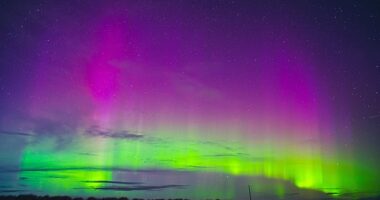OUR Solar System used to have an extra planet that ‘escaped’, according to new research.
Scientists at the Carnegie Institution for Science are claiming there was a third ‘ice giant’ between Uranus and Saturn.
New evidence suggests this planet was ‘flung out’ of our Solar System when it was in its early days of formation.
One widely acknowledged theory is that the Sun used to be surrounded by gas and dust which collided to form planets.
We currently have eight planets in our Solar System.
There was once considered to be nine planets but Pluto lost its planet status 2006.
Researches created 6,000 computer simulations to try and work out what the Solar System’s planets looked like when they first formed and what position they were in.
Carnegie postdoctoral fellow Matt Clement said: “We now know that there are thousands of planetary systems in our Milky Way galaxy alone.
“But it turns out that the arrangement of planets in our own Solar System is highly unusual, so we are using models to reverse engineer and replicate its formative processes.
“This is a bit like trying to figure out what happened in a car crash after the fact — how fast were the cars going, in what directions, and so on.”
The simulations showed that it was likely an “ejected ice giant”, similar to Uranus and Neptune, was kicked out of our planetary system as it was forming and went into deep space.
Clement said: “This indicates that while our Solar System is a bit of an oddball, it wasn’t always the case.
“What’s more, now that we’ve established the effectiveness of this model, we can use it to help us look at the formation of the terrestrial planets, including our own, and to perhaps inform our ability to look for similar systems elsewhere that could have the potential to host life.”
This study has been published in the journal Icarus.
A whole new world: What is Planet X?
Here’s what you need to know…
- Planet X is a theoretical a theoretical ninth planet that may be lurking in the farthest reaches of our Solar System
- Also known as Planet Nine, the hypothetical world has never been observed and the jury’s still out on whether it actually exists
- Planet X was first suggested in 2016 by astronomers at the California Institute of Technology to explain the wobbly orbits of distant objects
- The space bodies in question lie in the Kuiper Belt, a region beyond Neptune filled with dwarf planets and icy debris
- Scientists think the gravitational pull of an as-yet undiscovered ninth planet in the Solar System could be yanking the objects into strange orbits
- Planet X is said to have a mass about 10 times that of Earth and orbit 20 times farther from the Sun than Neptune
- It may take between 10,000 and 20,000 Earth years to make one full orbit around the Sun
In other space news, a huge asteroid that’s following Mars’s orbit could be our Moon’s ‘long-lost twin’.
It’s a good week to learn about all the planets in our Solar System as an impressive six will be visible in the night sky.
And, a huge asteroid nicknamed the ‘God of Chaos’ is gaining speed as it travels towards Earth.
What do you think of the ‘extra planet’ theory? Let us know in the comments…
We pay for your stories! Do you have a story for The Sun Online Tech & Science team? Email us at [email protected]
This post first appeared on Thesun.co.uk
















